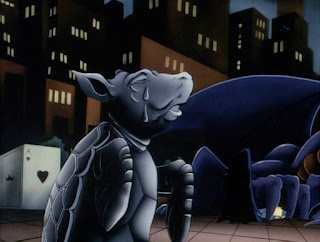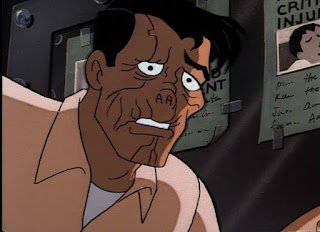Batman: The Animated Series Re-Watch: Episode Twenty Seven: Mad as a Hatter
Plot: WayneTech employee Jervis Tetch has invented a mind control device, which he uses to court Alice, his work-place crush, on an Alice in Wonderland inspired date. Then he just takes over her mind. Enter Batman.
 The Mad Hatter is a relatively straightforward villain, hat-obsessed mind controller inspired by Lewis Carroll, who nevertheless has had varied interpretations of the years, usually having some perversion in some way. In some, and I'm looking at you Gail Simone, his hat obsession is a full blown sexual fetish. In others, Alice in Wonderland is the book Martha Wayne used to read Bruce, so he's a perversion of Batman's idyllic childhood. For the past twenty years or so, he's been portrayed as a pedophile, playing on the rumors of Lewis Carroll's relationship with Alice Liddell.
The Mad Hatter is a relatively straightforward villain, hat-obsessed mind controller inspired by Lewis Carroll, who nevertheless has had varied interpretations of the years, usually having some perversion in some way. In some, and I'm looking at you Gail Simone, his hat obsession is a full blown sexual fetish. In others, Alice in Wonderland is the book Martha Wayne used to read Bruce, so he's a perversion of Batman's idyllic childhood. For the past twenty years or so, he's been portrayed as a pedophile, playing on the rumors of Lewis Carroll's relationship with Alice Liddell.While this episode does not quite go that far, he's certainly the Animated Series's first attempted rapist. There's no other interpretation of what Tetch was going to do after kidnapping, brainwashing, and then dressing his Alice up. As adults, we can't assume he just wanted to have tea with her. Like Mojo, the Mad Hatter is one of the more disturbing of Batman villains for using fantastic technology to commit very real and all too common crimes.
This is made all the more disturbing because Tetch is the protagonist of this episode, and a sympathetic one at that. We're actually supposed to feel kind of sad his love for Alice perverts him into the monster we see at the end (as indicated by the crying Mock Turtle statue). We can see he's brilliant, that his boss doesn't appreciate him, but Bruce Wayne, his boss's boss, does, and that he genuinely seems to care for Alice. We can see why he would use his device to pretend to be a celebrity. His date with Alice is a fabulous bit of wish fulfillment.
A lot of credit for the sympathetic portrayal belongs to Roddy MacDowell's voice work which is kind, awkward, nervous, and totally reasonable when we meet him, then turns darker, meaner, and more controlling as the episode progresses. (His combination of obvious intelligence and subtle menace is how I wish the Scarecrow sounded)
We watch Tetch turn into a villain over the course of the episode, and not for revenge like most of the supervillains we've met so far. Even from the beginning of the date, we can see that Tetch is a psychopath in a clinical sense. When he saves Alice from muggers, he off-handedly tells them to jump in the river. He may not have meant to kill them, which in fact would be worse. He does not see anyone but Alice and himself as human, and has no trouble using people as puppets, and by the end of the episode he uses Alice as a puppet as well.
Tetch gets crazier and crazier (or, as he says, "curiouser and curiouser") as the episode progresses. It's whimsical to show up for a date dressed as the Mad Hatter, but Tetch goes to work in the costume the next day. Thwarted, he crushes roses in his hand, and starts bleeding, and we haven't seen blood since the first episode. He becomes paranoid, gathering an army of henchmen BEFORE he has any reason to believe that Batman is after him. (At least he stole their on-theme costumes, rather than stay up all night sewing them himself.) And at the end, the Mad Hatter blames BATMAN for making him mind-control Alice, though it's clear he as going to do that whether Batman showed up or not.
His paranoia changes how he controls people too. During the date, he only uses his mind control cards to make people who are otherwise acting normal treat him better. Afterwards, as Alice slips away from him, he starts using the cards to change people, first turning Billy against Alice, then literally dressing up the people around him as the characters in his favorite book. It's not a coincidence that Batman fights the Mad Hatter's army on a chessboard, since these are his pawns.
The showdown at the storybook land has some of the Animated Series few nods to realism. Structurally, it's as much of a fantasy fight setting as the temple complete with death traps in Joker's Favor or the giant gears in the clock tower in Clock King, but here, the maze of cards is really built for children. So when Batman becomes trapped in it, he simply climbs out, cause he's Batman. (It also contains a zinger from Alfred that gets a chuckle even out of Batman, that Bruce Wayne's usual breakfast is "toast, coffee, and bandages.")
This is yet another beautifully put together episode. The designers went to town on playing with the Alice in Wonderland theme, starting with the John Tenniel inspired title card, to the mice drinking while wearing tiny fez, to the obviously costumes and yet still terrifying wardrobe of the Hatter's goons. We know Tetch's boss will be the Queen of Hearts almost from the moment we meet her. And we know it's all over the Jabberwocky itself comes for Tetch, subtly implying that Batman himself has "the claws the catch." All in all, this episode is one of the better pairings of Batman's fantasy trappings to a core plot about a very real crime.






















































